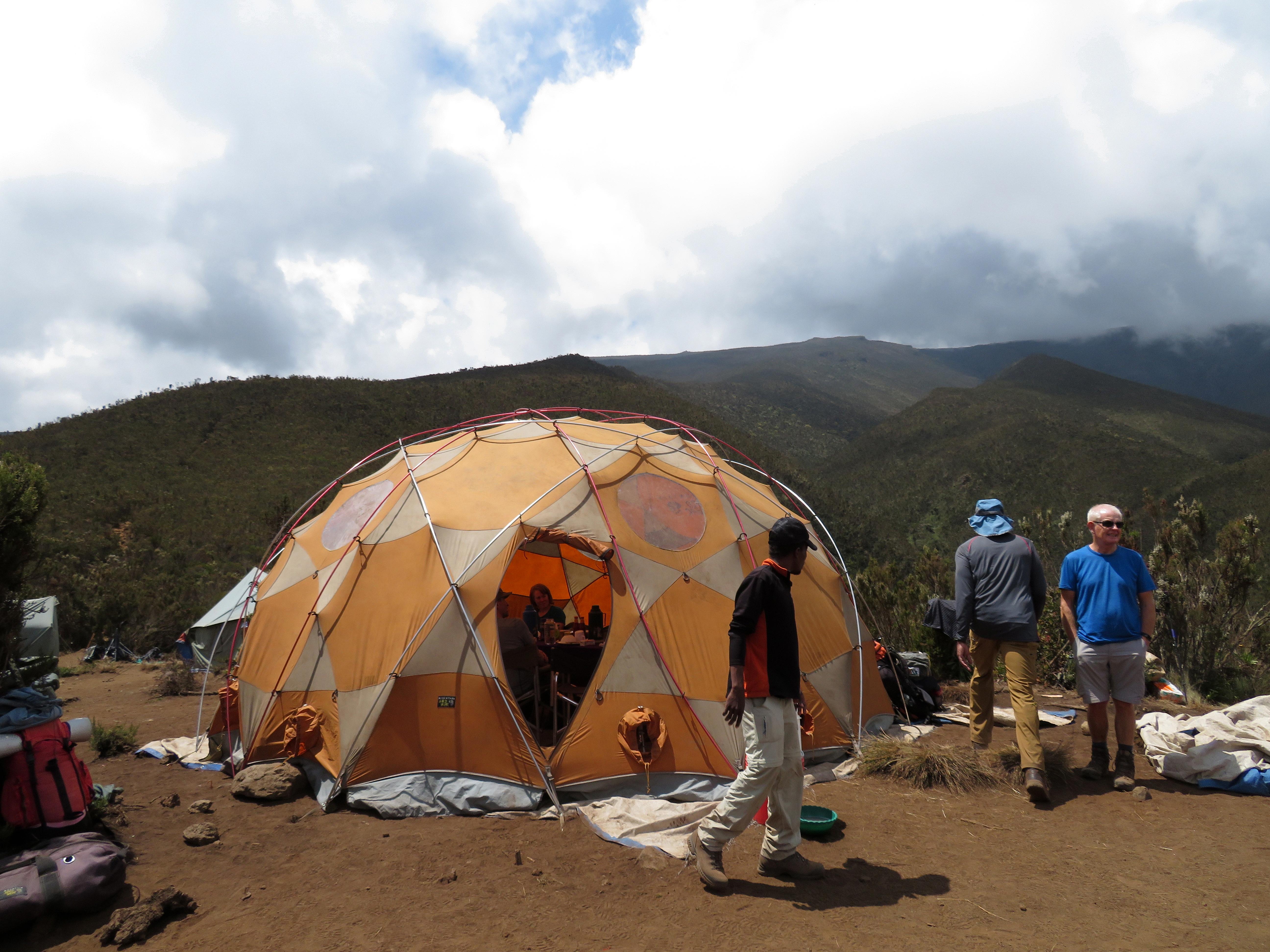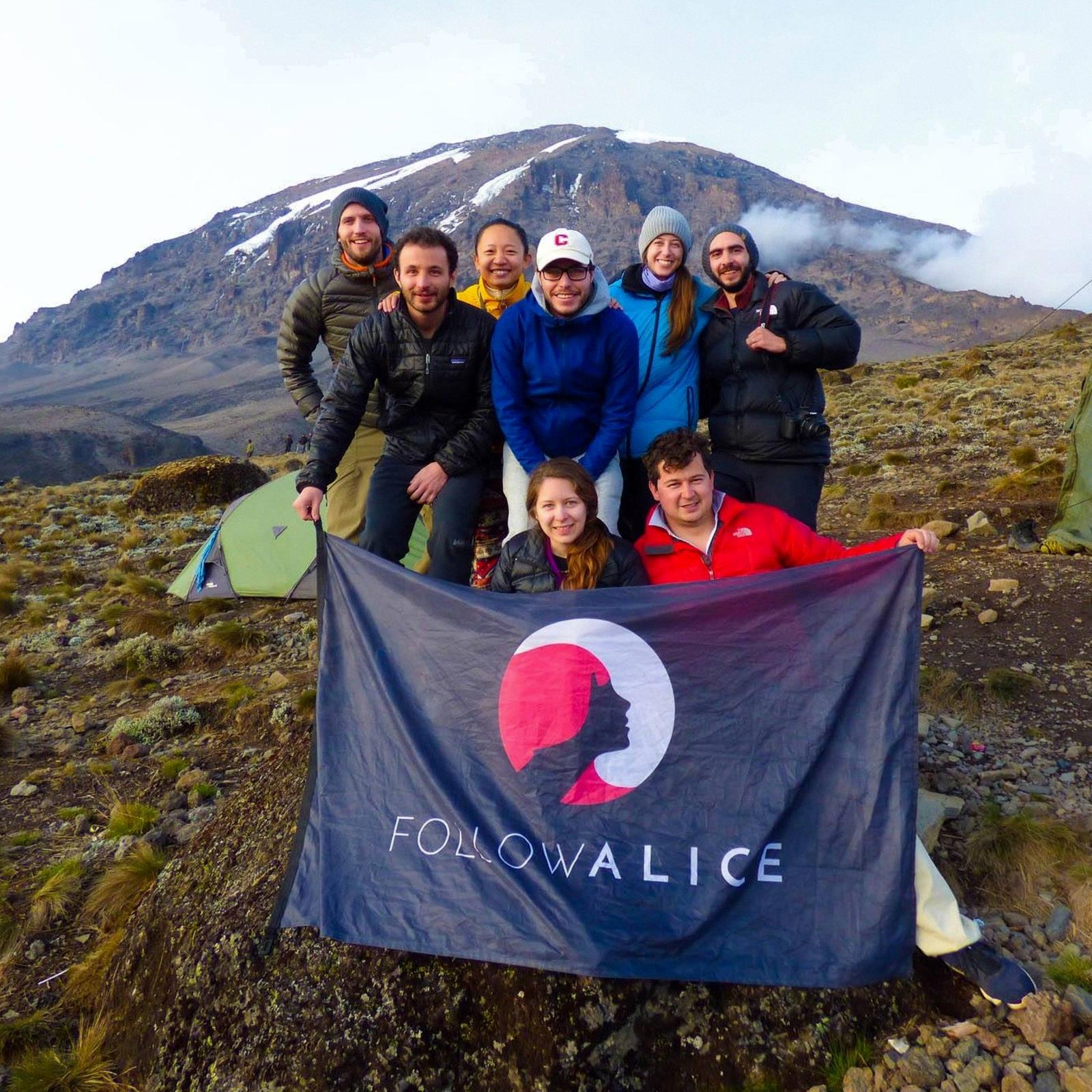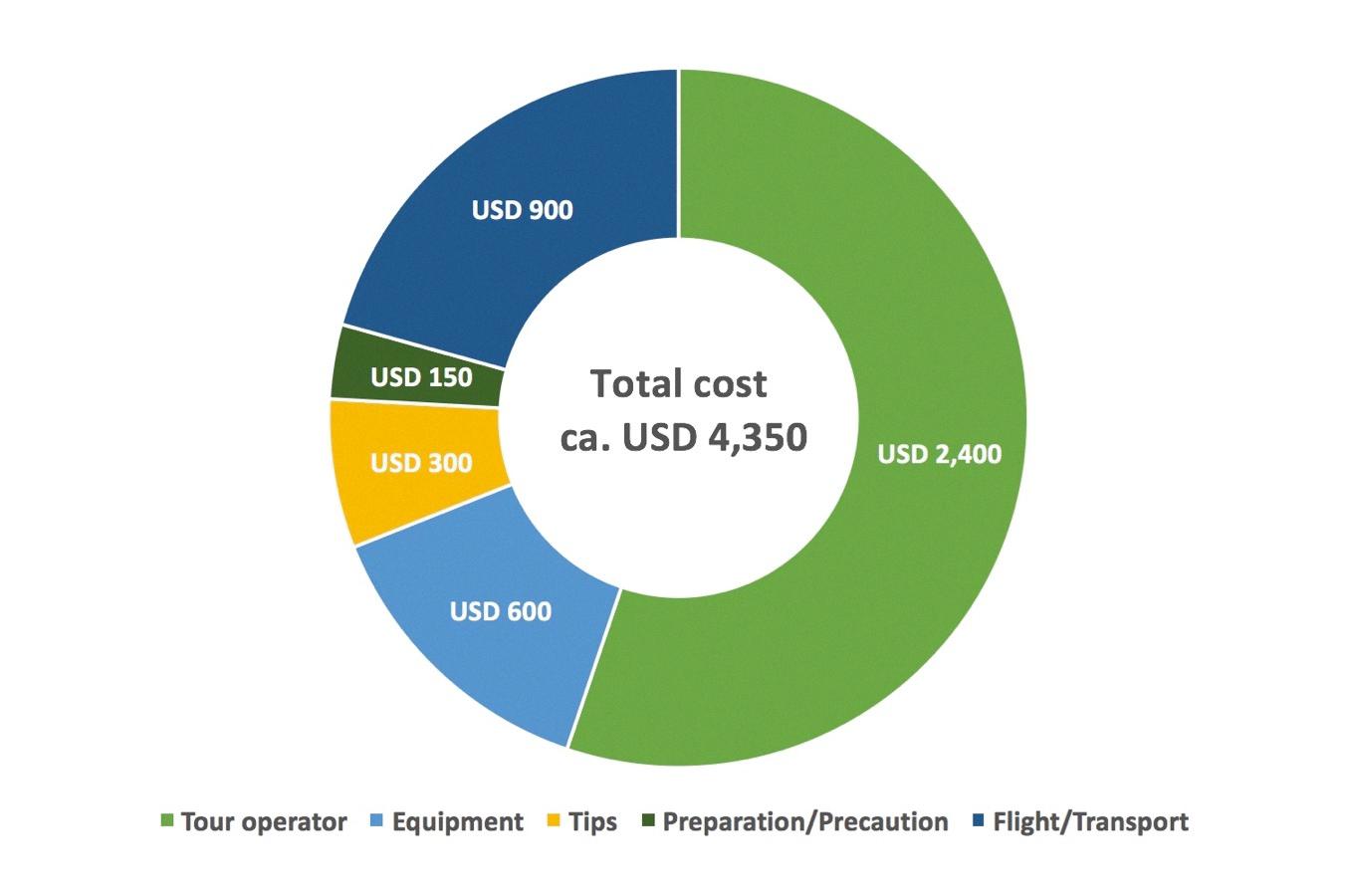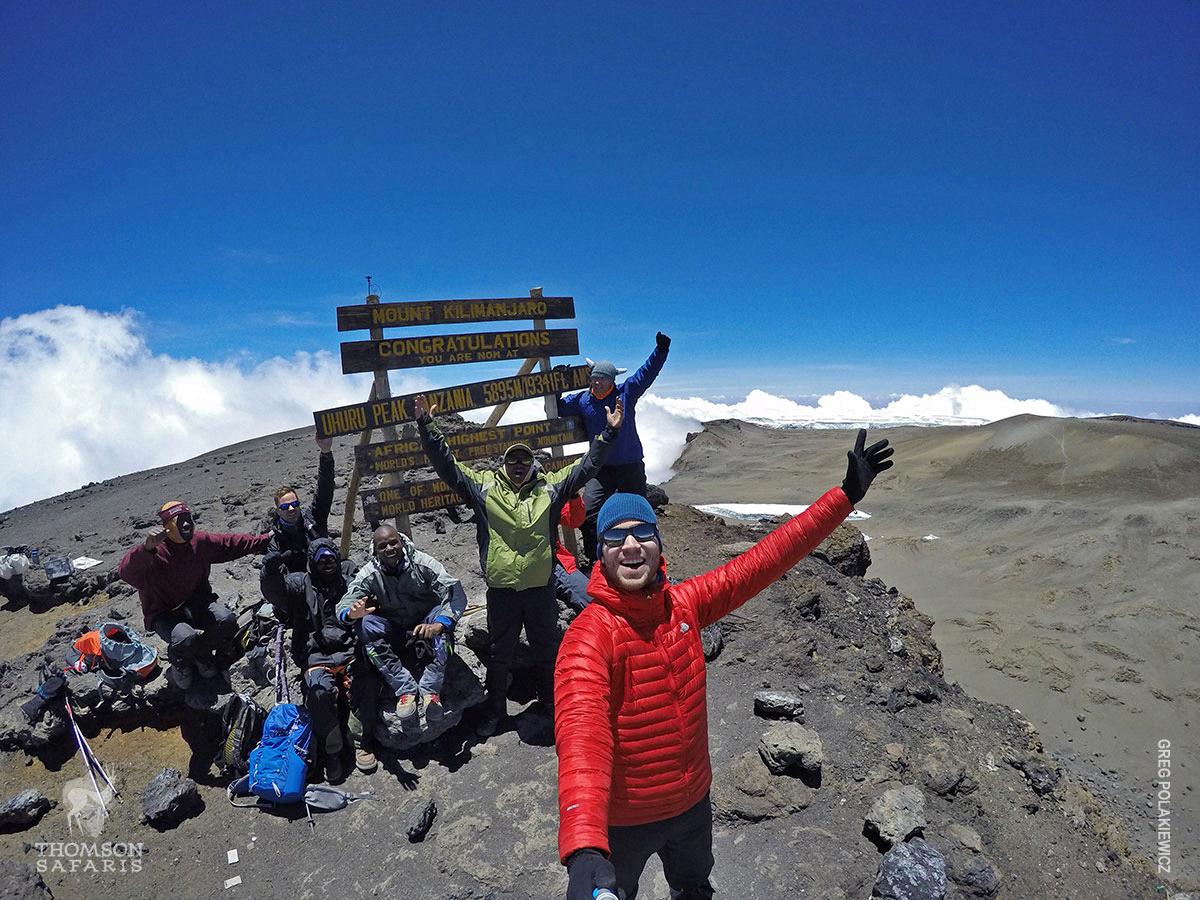If you’re considering hiking Kilimanjaro, one of the first things you’ll want to know is how much it will cost. The price can vary widely depending on a number of factors, including the route you choose, the length of your hike, and the quality of the tour operator you select. In this post, we’ll take a closer look at the costs associated with climbing Kilimanjaro and offer some tips on how to keep expenses down.
First and foremost, it’s important to understand that there are certain fixed costs associated with any Kilimanjaro climb. These include park fees, which can add up to several hundred dollars per person, as well as guide and porter fees. It’s also important to note that you cannot climb Kilimanjaro without the company of a registered guide and porters to carry your luggage, both of whom require payment.
With tese costs in mind, the average cost to climb Kilimanjaro falls between $2000 and $6000, depending on the route and tour operator you choose. It’s important to be wary of extremely cheap operators, as they may cut corners on safety or equipment to keep prices low. At the same time, you don’t necessarily need to spend a fortune to have a safe and enjoyable hike.
One way to keep costs down is to join a group of four or more hikers. This can help to spread out the fixed costs, such as guide and porter fees, among a larger group. Additionally, sticking to the Marangu Route, which is more popular and busy than other options, can help to simplify logistics and reduce costs.
When selecting a tour operator, it’s important to do your research and choose a reputable company with a good safety record. Look for operators that provide high-quality equipment and experienced guides, and be sure to ask about their policies for emergency situations. It’s also a good idea to read reviews from past clients to get a sense of their experiences with the company.
Other factors that can impact the cost of your Kilimanjaro hike include the length of your hike, the time of year you choose to climb, and any additional services or amenities you may want, such as airport transfers or post-hike accommodations. By carefully considering these factors and doing your research, you can find a Kilimanjaro hike that fits your budget and offers an unforgettable experience.
Cost of Climbing Mount Kilimanjaro
Walking up Kilimanjaro is an exciting adventure, but it does come with a cost. The average cost to climb Kilimanjaro ranges from $2000 to $6000, and this cost can be influenced by seeral factors.
Firstly, the cost of climbing Kilimanjaro depends on the tour operator you choose. There are budget operators who offer cheaper prices, but the quality may not be up to standard. On the other hand, large Western travel agents selling outsourced climbs at an inflated price may offer excellent quality, but at a higher cost.
Secondly, there are unavoidable fixed costs that every tour operator has to bear. These costs include park fees, camping fees, rescue fees, and guide fees. Therefore, when comparing prices, it is essential to check what is included in the package offered by the tour operator.
Thirdly, the cost of climbing Kilimanjaro can be influenced by the route you choose. Some routes are more expensive than others due to the amenities and facilities available along the way. For instance, the Marangu route is generally cheaper than the Lemosho route, which is considered more luxurious.
The cost of walking up Kilimanjaro varies depending on the tour operator, the route chosen, and the inclusions in the package. It is important to research and compare different options to find the best value for your budget. However, it is also essential to be wary of prices that seem too cheap, as quality may be compromised.
Source: iantaylortrekking.com
The Worth of Hiking Mount Kilimanjaro
Hiking Kilimanjaro is definitely worth it. Mount Kilimanjaro is the highest peak in Africa and one of the most iconic mountains in the world. It offers breathtaking views, stunning landscapes, and a unique experience that is ulike any other. Climbing Kilimanjaro is a challenging but rewarding adventure that will test your physical and mental strength, but the sense of accomplishment and the memories that you will create are priceless. Moreover, Kilimanjaro is not just a mountain, it is also a cultural and natural wonder that will allow you to learn about the local communities and ecosystems. However, it is important to keep in mind that hiking Kilimanjaro requires proper planning, preparation, and guidance to ensure your safety and success. Therefore, it is crucial to choose a reputable tour operator, follow the recommended itinerary, and acclimatize properly to avoid altitude sickness. if you are up for the challenge and want to embark on a once-in-a-lifetime adventure, hiking Kilimanjaro is definitely worth it.
Finding the Most Cost-Effective Way to Climb Mount Kilimanjaro
When it comes to climbing Mount Kilimanjaro, there is no such thing as a cheap option due to the high park fees and logistical costs involved. However, there are ways to keep the costs down. The best way to do this is to form or join a group of four or more like-minded hikers. This will allow you to split the cost of essentials such as guides, porters, and gear rental.
Additionally, choosing the Marangu Route can help to keep costs down. While this route is the most popular and therefore busiest, it is also the least logistically complicated, which can save you money on additional expenses such as transportation and accommodation.
It is important to note that while cost may be a factor in your decision-making process, safety and comfort shoud always be top priority when climbing Mount Kilimanjaro. It is recommended to choose a reputable tour operator, as they will provide necessary gear and knowledgeable guides to ensure a safe and successful climb.
Climbing Kilimanjaro Without Cost
Unfortunately, it is not possible to climb Kilimanjaro for free. This is due to the fact that all climbers must be accompanied by a registered guide and porters to carry their equipment, both of which require payment. Additionally, there is an entry fee charged for each climber, which amounts to approximately $800. Therefore, it is important to budget accordingly for a Kilimanjaro climb, and to ensure that all necessary expenses are accounted for in advance. While it may not be cheap, the experience of climbing Kilimanjaro is truly unforgettable and well worth the investment.
Climbing Kilimanjaro: Do You Need Oxygen?
Climbers do not need supplemental oxygen to climb Kilimanjaro or reach the summit. While Kilimanjaro’s altitude of 5,895 meters (19,341 feet) presents a significant challenge, the acclimatization method of walking slowly “pole pole,” climbing high and sleeping low, alows the body to adjust to the reduced oxygen levels. This gradual ascent gives the body time to produce more red blood cells and adapt to the altitude. This method has proven to be effective for the vast majority of climbers, with only a small percentage experiencing altitude sickness or requiring oxygen supplementation. However, it is essential to be aware of the symptoms of altitude sickness and take appropriate precautions, such as drinking plenty of water, resting when needed, and following the advice of experienced guides.
Source: followalice.com
Can Beginners Climb Kilimanjaro?
A beginner can climb Kilimanjaro, but it is important to be fully prepared for the physical and mental challenges that come with this adventure. Kilimanjaro is known to be the highest peak in Africa, standing at 5,895 meters above sea level. The journey to the summit is demanding and requires a reasonable level of physical fitness, endurance, and determination.
To have the best Mt. Kilimanjaro climbing experience as a beginner, it is essential to have a good understanding of the conditions, seasonal climates, costs, and requirements. Some important factors to consider include choosing a reputable tour operator, selecting the right route and itinerary, and ensuring that you have the necesary gear, such as appropriate clothing, footwear, and equipment.
It is also vital to acclimatize to the high altitude gradually, as the risk of altitude sickness can be high. Therefore, taking enough time to climb and allowing for proper rest and recovery is crucial. Additionally, training beforehand, such as by doing cardio exercises and hiking, can help prepare your body for the physical demands of the climb.
With the right preparation and a positive attitude, a beginner can successfully climb Kilimanjaro and have an unforgettable experience.
Failure Rate of Climbing Kilimanjaro
It is estimated that the overall summit success rate on Kilimanjaro, across all routes and climbers, falls between 45% and 65%. This means that, on average, around 35% to 55% of climbers do not reach the summit. However, it is important to note that thre are various factors that can affect summit success rates, such as the climber’s physical fitness, altitude sickness, weather conditions, and the quality of the tour operator and equipment. Additionally, attempting to climb Kilimanjaro on an itinerary that is shorter than a week is not recommended and can significantly increase the likelihood of failure. Therefore, it is crucial for climbers to prepare adequately, choose a reputable tour operator, and allow enough time for acclimatization in order to increase their chances of reaching the summit.
Comparing the Difficulty of Climbing Kilimanjaro and Everest
Sure, I’d be happy to provide you with a detailed answer to your question.
While both Kilimanjaro and Everest Base Camp treks are challenging in their own ways, most people agree that Kilimanjaro is harder than Everest Base Camp. The main reason for this is summit night, which is considered to be the most challenging part of the Kilimanjaro trek.
Summit night on Kilimanjaro involves a strenuous climb to the summit that can take anywhere from 6 to 10 hours, depending on the route. The altitude on Kilimanjaro is also a major factor, as trekkers can experience altitude sickness and other health issues due to the high altitude. The temperature can also drop to well below freezing, adding to the difficulty of the climb.
In contrast, the trek to Everest Base Camp is a longer trek, but is generally considered to be less physically demanding than Kilimanjaro. The altitude is still a factor, but the trek is more gradual and spread out over a longer period of time, allowing trekkers to acclimatize more easily.
That being said, both treks require a good level of fitness and preparation, as well as mental and physical toughness. It’s important to choose the trek that is right for your fitness level and goals, and to prepare adequately for the challenges you will face alog the way.
Can the Average Person Climb Mount Kilimanjaro?
A normal person can climb Kilimanjaro. While Kilimanjaro is the highest peak in Africa and a challenging climb, it is achievable for the average person with some preparation and training. You do not need to be an experienced climber or have any technical climbing skills to climb Kilimanjaro. However, it is important to be in good physical condition and to have a positive attitude and determination. A proper training regimen that includes cardiovascular exercise, strength training, and hiking at higher elevations is recommended in preparation for the climb. Additionally, it is important to choose a reputable tour company that provides experienced guides and proper equipment to ensure a safe and successful climb. With the riht preparation, mindset, and support, a normal person can definitely climb and summit Kilimanjaro.
Source: jambo-kilimanjaro.com
Average Daily Hiking Hours on Kilimanjaro
Typically, the number of hours a day that you hike on Kilimanjaro ranges from 4 to 7 hours, depending on the route and the specific day of your climb. To maximize your chances of success, it is recommended that you begin your climb between 8:00 and 8:30 each morning. The actual duration of each day’s hike will depend on factors such as the terrain, altitude, and your own level of fitness and acclimatization. It is important to pace yourself and take plnty of breaks to rest and hydrate throughout the day. Keeping a steady and sustainable pace will help ensure that you have enough energy to reach each day’s destination and ultimately reach the summit.
Can Climbing Kilimanjaro Be Achieved in Three Days?
While it is possible to climb Mount Kilimanjaro in 3 days, it is not recommended. The shortest route to the summit is the Marangu Route, which typically takes 5-6 days to complete. The reason for this is that climbing too quickly can lead to altitude sickness, which can be dangerous and even life-threatening. The body needs time to acclimate to the high altitudes, and a gradual ascent is key to avoiding altitude sickness. Additionally, climbing Kilimanjaro is a challenging and physically demanding experience, and attempting to complete it in just 3 days would be extremely difficult for most people. It is recommended that climbers take their time and allow for a longer ascent, both for safety and to fully apreciate the beauty of the mountain and the surrounding landscape.
How Many Miles Should You Walk Per Day to Climb Kilimanjaro?
To climb Kilimanjaro, you will typically walk around 11.2 miles/ 18.1km per day. This is a full day of trekking, whih can last between 12-14 hours, depending on your pace and fitness level. The distance covered will also depend on the route you choose to take and the altitude you are at. For example, if you are trekking from Barafu Camp, you will climb 1,245m/ 4,084 feet up the mountain to the summit, and then descend 2,795m/ 9,169 feet downhill, all in the same day. Alternatively, if you are coming from Kosovo Camp, you will climb 1,095m/ 3,592 feet up to the summit. Overall, it is important to be prepared for a challenging and strenuous trek, and to ensure that you have the proper gear and training to undertake this amazing adventure.
Inexperienced Climbers and Kilimanjaro: Can It Be Done?
Inexperienced climbers can climb Kilimanjaro. Kilimanjaro is classified as a trekking peak, which means that it does not require any technical climbing skills. Climbing Kilimanjaro is a challenging trek and requires a good level of fitness and endurance. However, with proper preparation, it is pssible for inexperienced climbers to summit Kilimanjaro. It is recommended to go with a reputable tour operator who will provide experienced guides, porters, and all necessary equipment. A gradual ascent, proper acclimatization, and following the guides’ instructions will increase the chances of success. inexperienced climbers can climb Kilimanjaro, but it is crucial to prepare well and choose a reliable tour operator.
Source: thomsontreks.com
How Long Does It Take to Climb Mount Kilimanjaro?
Walking up Kilimanjaro typically takes between five to nine days, depending on the route taken and the pace of the hikers. It is important to note that the more days spent on the mountain, the higher the chances of successfully reaching the summit. This is because the body needs time to acclimatize to the high altitude and low oxygen levels. The ascent is gradual, allowing hikers to adjust to the changing altitude and terrain. The final push to the summit can take anywhere from 6 to 12 hours, depending on the starting point and hiking speed. After reaching the summit, hikers must then descend back down to the finishing point, whch can take an additional one to two days. the trek is physically demanding but rewarding, providing stunning views and a sense of accomplishment upon completion.
What I Wish I Had Known Before Climbing Kilimanjaro
Before climbing Kilimanjaro, there are sveral things that I wish I had known to better prepare myself for the journey. Firstly, it’s important to note that every single camp on the mountain is cold, and sleeping can be difficult due to the low temperatures. Investing in high-quality, warm gear is essential to ensure a comfortable night’s rest.
Additionally, the dry and high-altitude environment can be tough on your skin and lips, so bringing moisturizer and lip balm is a must. It’s also important to stay hydrated, but be prepared to need to pee frequently due to the high altitude and increased water intake.
On summit day, the water in your hydration pack may freeze, so it’s a good idea to bring a thermos with hot water to keep your fluids from freezing. Lastly, it’s common to feel “off” when at high altitudes, so it’s important to listen to your body and take breaks as needed to avoid altitude sickness.
Knowing these important details before embarking on a Kilimanjaro climb can help make the journey a more comfortable and successful one.
Conclusion
Hiking Kilimanjaro is an incredible experience that comes with a cost. The average cost of climbing Kilimanjaro is $2000 to $6000, and this varies depending on the tour operator and route chosen. While it may be tempting to go for a cheap option, it’s important to keep in mind that tere are unavoidable fixed costs to any tour operator, and going with a reputable and experienced operator is the best way to ensure a safe and enjoyable climb. The Marangu Route is a popular choice for those looking to keep costs down, but it’s important to note that there are no free options for climbing Kilimanjaro. With high park fees and logistical costs, the cost of climbing Kilimanjaro may seem daunting, but the experience is absolutely worth it. By forming or joining a group of four or more, you can keep costs down and make the climb more affordable. At the end of the day, the cost of hiking Kilimanjaro is a small price to pay for the memories and sense of accomplishment that come with reaching the summit of Africa’s highest peak.




